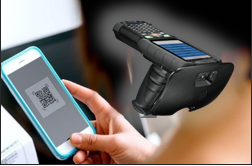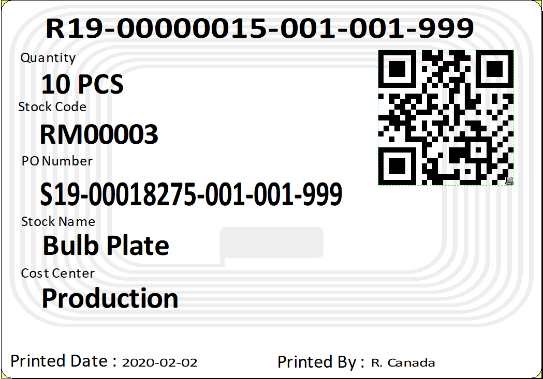QR INVENTORY
Posted on 2020-10-21

“What we can properly measure, is what we can improve and optimize.” This is a common truth about the continuous performance process. And of course, these improvements and optimizations are needed to be monitored to see its results and gather adjustments for the next performance improvement cycle.
When talking about Inventory Control, doing all the proper measuring, optimizing and monitoring of your warehouse inventory is not just a walk in the park. And yes, the bigger the volume of your inventory, the strenuous it gets.
A basic requirement, is for you is to have a comprehensive process. Within your processes, you may choose to equip with tools for better speed and convenience. Fortunately, with the advancement of the technology, these tools have become very handy and readily available to be integrated to various Inventory Control Systems.
A very common technology that has been around for a more than half a century now, the BARCODE.
History and Evolution of Barcode Technology
Barcode was first invented Norman Joseph Woodland and Bernard Silver based on the Morse Code. Through this technology, data can be represented in a visual and in a machine-readable form.
Linear Barcodes or One-dimensional barcodes, are the first of its generations that are made up of lines and spaces of various widths that create specific patterns. This type of barcode has been around for quite some time already and is still being widely used in many contexts such us in stock control operations.
As being its first generation of the technology, Linear barcodes already serves as a fundamental tool despite of its known limitation, its Data Storage. The varying width and lines of 1D barcode usually limits users on the data they wanted to encode in the visual representation because of the printing space availability. The longer the data you want to keep, the longer the barcode will be.
Matrix Barcodes or Two-dimensional barcodes, are the next generation barcodes that enables users to encode more data even images (binary data) in a small space using two-dimensional symbols and shapes.
The QR Code System was invented in 1994 by Masahiro Hara from the Japanese company, Denso Wave.
Its main purpose is to enable high-speed component scanning in vehicles manufacturing. A few decades later, it has already been used worldwide into much broader context and has become one of the most-used type of the Matrix Barcode.
Error Correction:
QR codes use Reed–Solomon error correction.
Reed–Solomon codes operate on a block of data treated as a set of finite-field elements called symbols. Reed–Solomon codes are able to detect and correct multiple symbol errors. By adding t = n − k check symbols to the data, a Reed–Solomon code can detect (but not correct) any combination of up to and including t erroneous symbols, or locate and correct up to and including ⌊t/2⌋ erroneous symbols at unknown locations. As an erasure code, it can correct up to and including t erasures at locations that are known and provided to the algorithm, or it can detect and correct combinations of errors and erasures. Reed–Solomon codes are also suitable as multiple-burst bit-error correcting codes, since a sequence of b + 1 consecutive bit errors can affect at most two symbols of size b. The choice of t is up to the designer of the code and may be selected within wide limits.
Due to error correction, it is possible to create artistic QR codes that still scan correctly, but contain intentional errors to make them more readable or attractive to the human eye, as well as to incorporate colors, logos, and other features into the QR code block.
https://en.wikipedia.org/wiki/Reed%E2%80%93Solomon_error_correction
https://en.wikipedia.org/wiki/QR_code

Benefits
Cost – 2D barcodes must be read using a scan engine type known as an imager. Unlike with 1D barcodes, where it uses a traditional laser-type scanner, a 2D barcode imager can already scan both linear and 2-dimensional barcodes making it more cost-efficient for systems having a hybrid implementation of both barcode types.
Convenience – They are flexible in size and offer a high fault tolerance and have fast readability. 1D barcode scanners are extremely limited in the angle at which it must scan 1D barcodes. The main benefit of 2D imager is that it is omnidirectional and can read better even on a damaged or poorly printed barcode from any angle.

Storage – The more data you can store to the visual representation with 4 modes of data: numeric, alphanumeric, byte/binary and even Kanji.
Versatility – Can be scanned on just about any device with scanning capabilities like computers like smartphones and handheld devices.
Application

QR Barcode has been invented and widely used for Industrial and Consumer Goods for stock control and management. Now, more and more applications like marketing and advertising have been also using this method because of its benefits mentioned above.
In NXPERT Warehouse Management Solution, the QR barcode technology has been integrated to its comprehensive system workflow. It can optimize your stock management by utilizing the QR barcodes tagged to your inventories through a versatile mobile handheld computer in every stock movement activity.

With the QR Barcoding System integrated with the NXPERT Warehouse Management Solution, you will greatly enjoy the benefits of an optimized warehouse management and stock control monitoring. Take leverage to improve your business process to a newer level!
Recent Blogs